
 |
Dr. Andy Shearer - Lecturer Andy Shearer is a lecturer in the IT dept. of NUI Galway. He started the scientific computing group in 1996. His scientific interests include: Optical pulsars - observations and modelling; High-time resolution astrophysics - detector development and observational programme; Imaging - restoration of medical and astronomical images; Medical physics & computing - radiative transfer simulations for diagnostic purposes - patient treatment planning and photo-dynamic therapy; High performance computing - coordinated the college's purchase of an SGI Origin 3800. Andy Shearer is a lecturer in the IT dept. of NUI Galway. He started the scientific computing group in 1996. His scientific interests include: Optical pulsars - observations and modelling; High-time resolution astrophysics - detector development and observational programme; Imaging - restoration of medical and astronomical images; Medical physics & computing - radiative transfer simulations for diagnostic purposes - patient treatment planning and photo-dynamic therapy; High performance computing - coordinated the college's purchase of an SGI Origin 3800.
Dr. Aaron Golden - Lecturer Aaron Golden is also a lecturer in the IT dept. of NUI Galway.
He has degrees in Experimental Physics, Computational Science and Astrophysics, and has been involved in the Scientific Computing Group since its foundation. He has worked previously at the Max Planck Institute for Gravitational Physics and at the Space Sciences Laboratory at UC Berkeley. His scientific interests
include: Various topics in Astrophysics (neutron stars, pulsar-supernova remnant interactions, extrasolar planets),
High performance computing (modelling of relativistic/nonrelativistic plasmas, aerosol/dust opacity, signal processing techniques), Imaging (restoration of radio astronomy images) and Econophysics. Aaron Golden is also a lecturer in the IT dept. of NUI Galway.
He has degrees in Experimental Physics, Computational Science and Astrophysics, and has been involved in the Scientific Computing Group since its foundation. He has worked previously at the Max Planck Institute for Gravitational Physics and at the Space Sciences Laboratory at UC Berkeley. His scientific interests
include: Various topics in Astrophysics (neutron stars, pulsar-supernova remnant interactions, extrasolar planets),
High performance computing (modelling of relativistic/nonrelativistic plasmas, aerosol/dust opacity, signal processing techniques), Imaging (restoration of radio astronomy images) and Econophysics.
Dr. Ray Butler - Post-doctoral fellow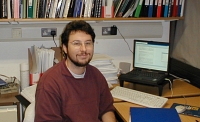 Ray Butler has been a postdoctoral researcher in the group since November 1999. After obtaining his doctorate on the photometry of the stellar populations in Globular Cluster Cores in the Physics Department of NUIG, he was awarded a two year Marie Curie Fellowship which he elected to hold at the University of Edinburgh. Here he worked on various problems in astronomical image processing. This work, in crowded-field photometry & astrometry, deconvolution, and instrument/detector response modelling and simulations (such as with the Hubble Space Telescope), still continues to some extent. His interests also now extend into other areas of research, including Medical Imaging and data reduction for the pulsar astrophysics programme. Ray Butler has been a postdoctoral researcher in the group since November 1999. After obtaining his doctorate on the photometry of the stellar populations in Globular Cluster Cores in the Physics Department of NUIG, he was awarded a two year Marie Curie Fellowship which he elected to hold at the University of Edinburgh. Here he worked on various problems in astronomical image processing. This work, in crowded-field photometry & astrometry, deconvolution, and instrument/detector response modelling and simulations (such as with the Hubble Space Telescope), still continues to some extent. His interests also now extend into other areas of research, including Medical Imaging and data reduction for the pulsar astrophysics programme.
In April 2001 he is commencing work under his second personal Marie Curie Fellowship, awarded by the European Commission; this project will be concerned with enhancing medical and adaptive optics imagery using parallel computing. His computer aptitude and general inability to say "no" have (unfortunately?!) landed him the job of system administrator for the I.T. Department's main number crunchers, the Alpha cluster. Setting up Linux on laptops has been the latest reason for the swearing noises coming from his corner of Rm 227. Anne Marie Kennedy - MSc candidate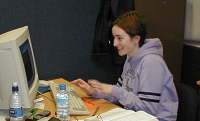 Anne Marie graduated in 1999, with a first class BSc. Experimental Physics from N.U.I., Maynooth, having spent 4 brilliant years there. She moved to Galway in October '99 to do a MSc. in Medical Imaging. She's gained a lot of knowledge about Light -Tissue interactions and the main area she's researching is Monte Carlo Simulations for Optical Radiation in Tissue. Anne Marie graduated in 1999, with a first class BSc. Experimental Physics from N.U.I., Maynooth, having spent 4 brilliant years there. She moved to Galway in October '99 to do a MSc. in Medical Imaging. She's gained a lot of knowledge about Light -Tissue interactions and the main area she's researching is Monte Carlo Simulations for Optical Radiation in Tissue.
Outside the 'office hours' she goes to karate. She joined the club here on arrival and it's great craic - once all the push ups are over! She started a Pilates class recently which really works the stomach muscles! The night life here is completely different to Maynooth, where there were 2 main pubs she frequented and the 'famous' GlenRoyal hotel ("people who know Maynooth know what i mean!!"). She's enjoying her time here in Galway and has met lots of fun people. Sarah Gundy - PhD candidate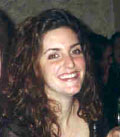 Sarah completed her B.Sc. in biology in May of 1998 at Creighton University, Omaha, Nebraska, USA. She went on to obtain a Higher Diploma in secondary education in May of 1999 from the same university. In October of 1999, she moved to Ireland to start her Ph.D. in physics at the NUI Galway, which she is presently working on. Sarah completed her B.Sc. in biology in May of 1998 at Creighton University, Omaha, Nebraska, USA. She went on to obtain a Higher Diploma in secondary education in May of 1999 from the same university. In October of 1999, she moved to Ireland to start her Ph.D. in physics at the NUI Galway, which she is presently working on.
Her project involves the use of photosensitizers and a fast-gated (200 psec) CCD camera to image malignancies. In her free time she likes to spend time with her dog, Wolfie, and pick up any strays that might also need a home (which the department is fully aware of!) Triona O'Doherty - PhD candidate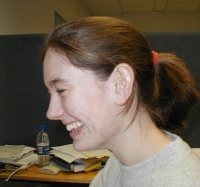 Triona has been working on medical image procssing since Sept '97. Her work concentrates on reducing scatter and noise in computed x-ray images.Techniques which have been developed for astonomical images were adapted for this purpose. Scatter reduction is achieved by deconvolution with a spatially varying point spread function and she uses wavelets for denoising. This processing algorithm is applied to the image after the x-ray has been taken. A scattering grid is not needed when the X-ray is being taken so the dose to the patient is reduced. Triona has been working on medical image procssing since Sept '97. Her work concentrates on reducing scatter and noise in computed x-ray images.Techniques which have been developed for astonomical images were adapted for this purpose. Scatter reduction is achieved by deconvolution with a spatially varying point spread function and she uses wavelets for denoising. This processing algorithm is applied to the image after the x-ray has been taken. A scattering grid is not needed when the X-ray is being taken so the dose to the patient is reduced.
In order to test the effect of this processing algorithm on the image she initially used phantom images and found that resolution increased by 50% and that noise decreased. At the moment she carries out a clinical trial in which radiologists are asked to assess the improvement in the image after the processing. Oliver Ryan - PhD candidate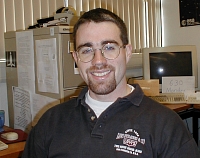 Ollie enjoyed the splendours that the University of Limerick had to offer (most notably The Stables bar) while studying for a BSc in Applied Physics (got a trip to Germany for 6 months out of it). Next he jumped into an MSc in Astronomy and Astrophysics with NUIG (college bar here is good too) which took him to Portugal for lectures and Chile for a project on comet Hale-Bopp for 6 months each, would you believe. Since going on to follow a PhD in the development of a novel photon-counting and imaging detector based upon position sensitive diodes and a lot of accursed C programming, he has seen the Canaries (nice telescopes) and more of Chile (more nice telescopes) for free again. Russia is on the cards somewhere down the line (big telescope there), Puerto Rico (nice beaches) and New York (nice city) have been done on personal time, so all that can be said is God Bless Astronomy. Ollie enjoyed the splendours that the University of Limerick had to offer (most notably The Stables bar) while studying for a BSc in Applied Physics (got a trip to Germany for 6 months out of it). Next he jumped into an MSc in Astronomy and Astrophysics with NUIG (college bar here is good too) which took him to Portugal for lectures and Chile for a project on comet Hale-Bopp for 6 months each, would you believe. Since going on to follow a PhD in the development of a novel photon-counting and imaging detector based upon position sensitive diodes and a lot of accursed C programming, he has seen the Canaries (nice telescopes) and more of Chile (more nice telescopes) for free again. Russia is on the cards somewhere down the line (big telescope there), Puerto Rico (nice beaches) and New York (nice city) have been done on personal time, so all that can be said is God Bless Astronomy.
Padraig O' Connor - PhD candidate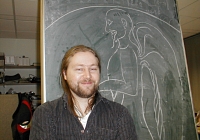 Padraig O' Connor completed a B.Sc. in Experimental Physics here in NUIGalway in 1997. He went to India that summer and has been constantly confused as to the nature of the universe and the secrets of life ever since. One mystery he has been working on since then is how pulsars emit non-thermal pulsed radiation in the optical region of the spectrum. (It may not sound as
exciting as learning how to survive in the middle of a sand dune for two and a half days without breathing but he can assure you it is just as challenging). He has been approaching the pulsar mystery by building a model of a pulsar and computationally carrying out a "search algorithm" over the 3D volume of the pulsar magnetosphere. Synchrotron radiation is the main emission process included (supposedly the only one relevant in optical) and he is currently working on including plasma effecs. This novel "inverse mapping" approach is computationally intensive but has yielded promising results (Texas
Symposium) and may hopefully help to localise emission regions within the pulsar magnetosphere (heretofore unknown). All this work has been done within the scientific computing group here and with the exception of a 3 month visit to the astronomy department, Cornell Univerity. Padraig O' Connor completed a B.Sc. in Experimental Physics here in NUIGalway in 1997. He went to India that summer and has been constantly confused as to the nature of the universe and the secrets of life ever since. One mystery he has been working on since then is how pulsars emit non-thermal pulsed radiation in the optical region of the spectrum. (It may not sound as
exciting as learning how to survive in the middle of a sand dune for two and a half days without breathing but he can assure you it is just as challenging). He has been approaching the pulsar mystery by building a model of a pulsar and computationally carrying out a "search algorithm" over the 3D volume of the pulsar magnetosphere. Synchrotron radiation is the main emission process included (supposedly the only one relevant in optical) and he is currently working on including plasma effecs. This novel "inverse mapping" approach is computationally intensive but has yielded promising results (Texas
Symposium) and may hopefully help to localise emission regions within the pulsar magnetosphere (heretofore unknown). All this work has been done within the scientific computing group here and with the exception of a 3 month visit to the astronomy department, Cornell Univerity.
Seathrun Ó Tuairisg - PhD candidate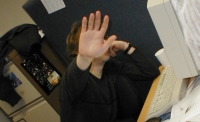 Seathrun Ó Tuairisg completed his degree in Experimental Physics at NUIG in 1997. He then studied the European Masters in Astronomy. This consisted of 6 months course lectures at the Universidade do Porto, followed by a research project on Diffuse Interstellar Bands (DIBs) towards heavily reddened targets at the University of Leiden, the Netherlands. Following a three-month trainee period at the European Space Research and Technology Centre in Noorvijk, Holland (ESTEC/ESA) where he researched molecular (mostly CH/CH+) and atomic (Na, Ca, and others) species and their effect on DIB enhancment, he returned to NUIG where he is currenty completing his PhD on deep field photometry of crowded globular cluster cores. Seathrun Ó Tuairisg completed his degree in Experimental Physics at NUIG in 1997. He then studied the European Masters in Astronomy. This consisted of 6 months course lectures at the Universidade do Porto, followed by a research project on Diffuse Interstellar Bands (DIBs) towards heavily reddened targets at the University of Leiden, the Netherlands. Following a three-month trainee period at the European Space Research and Technology Centre in Noorvijk, Holland (ESTEC/ESA) where he researched molecular (mostly CH/CH+) and atomic (Na, Ca, and others) species and their effect on DIB enhancment, he returned to NUIG where he is currenty completing his PhD on deep field photometry of crowded globular cluster cores.
Symeon Charalabides - PhD candidate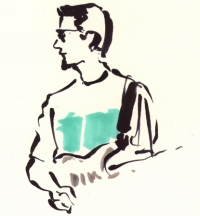 Symeon was born in the year of the Sting and is the research group's pet in that everybody wants him around although he's of no apparent use. Having succesfully dodged 7 years' worth of lectures in the maths dept. of the University of Athens, he somehow emerged victorious, owing in no small part to having spent the autumn of '95 as an Erasmus student in NUI. The latter introduced him to concepts like 'civility' and 'helpfulness'. The former familiarised him with the notions of 'patience' and 'insistence'. Also with numerous examples of 'ignorance', 'complex' and 'apathy'. Symeon was born in the year of the Sting and is the research group's pet in that everybody wants him around although he's of no apparent use. Having succesfully dodged 7 years' worth of lectures in the maths dept. of the University of Athens, he somehow emerged victorious, owing in no small part to having spent the autumn of '95 as an Erasmus student in NUI. The latter introduced him to concepts like 'civility' and 'helpfulness'. The former familiarised him with the notions of 'patience' and 'insistence'. Also with numerous examples of 'ignorance', 'complex' and 'apathy'.
Seeing that the only thing Greece could offer him was 18 months of blissful senselessness, he opted for the less manly alternative of studying for a PhD in NUI Galway, still feeling there was a debt to be repaid. A fellowship from the university and a research grant from Enterprise-Ireland, both running for 3 years, have only made the debt greater, but regular escapes to the continent help him forget. His work involves deconvolving Gamma-ray images, mostly the late EGRET ones, and subsequently trying to force specks of dust into being pulsars. Guinness helps there. Symeon's numerous on-line residences include A dream in blue, Systasis and the Irish Centre for High-End Computing. He cultivates his New Romantic sense of aesthetics and an aversion to revolving doors. |